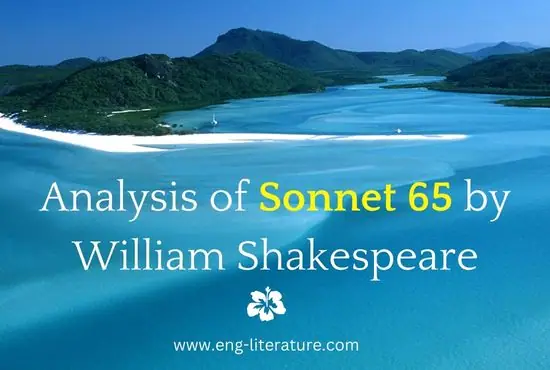Analysis of Sonnet 65 by William Shakespeare
Sonnet 65 by Shakespeare has the strain of the previous sonnet (No. 64) and be weeps the destructive effects of time. As in the other sonnet, the post dwells here on the invincible power of time to corrode and destroy all physical elements and material things. The rage of time to ruin is also emphasized here. None of the statue of brass, the wall of stone and the gate of steel can evade the decay caused by time. Even the solid earth, the boundless sea and the impregnable rock corrode and lose their shapes under the impact of time. There remain, only the grim truth that ‘sad mortality oversways’ all powers and that ‘time decays’
The whole though of the poet is plaintive and marks his sense of utter despondency. He cannot but mournfully admit that his friend’s tender beauty has no scope for survival against this rage of time. “How with this rage shall beauty hold a plea?” His loveliness and sweetness will not be spared by time.
This despondent feeling is aggravated further by the poet’s fearful realization that there is no power or force to resist the cruel blow of time or stop its swift march. A melancholy mood, thus, runs as in the previous sonnet all through this sonnet. The poet’s admission in the third quatrain is deeply moving and bears out the helpless human submission to cruel, unsparing time.
“Oh fearful meditation ! where, alack,
Shall Time’s best jewel from Time’s chest lie hid?
Or what strong hand can hold his swift foot back?
Or who his spoil of beauty can forbid?”
The poet’s tone here is truly tragic. Fearful mediations dominate his mind as he perceives how time is robbing the strength of nature and the sweetness of human beauty.
Also Read:
- Sonnet 18 Summary and Analysis
- Theme of Time and Love in Shakespeare’s Sonnet
- Shakespeare Sonnet 64 Analysis
- Shakespeare Sonnet 73 Critical Analysis
- Sonnet 73 Shakespeare | Summary, Theme, Line by Line Analysis
- Sonnet 116 Analysis
Of course, the sonnet is not all sad. It contains consolation, too, for the poet’s depressed heart. In the concluding couplet, the gloom of the poet’s tone is relieved by a note of his fervent hope. He is enlivened with his expectation of the enduring power of his verse to preserve his love and protect this from the decay of time. He states hopefully-
“That in black ink my love may still shine bright.”
This faith in the possibility of the survival of love through verse is quite unlike the absolute note of depression of the previous sonnet. But this echoes what is heard in a good many sonnets on the theme of time and love, as in the concluding couplet of the Sonnet No. 63.
“His beauty shall in these black lines be seen.
And they shall live, and he in them still green.”
This hope in the power of his art to stand against time to perpetuate his love is found to be an inspiring element in most Shakespearean sonnets on the time-love theme.
The sonnet, like the previous one, denotes specifically Shakespeare’s technical artistry of a very high degree. It illustrates the excellence of Shakespearean imagery in precision and vividness. The poet’s imagery of ‘summer’s honey’ against the wreckful siege of battering days’ is highly suggestive. The whole account, as noted rightly by Fowler, is equally wonderful in the splendid vividness of imagery and the perfect echo of the sense in the sound. ‘Rocks impregnable’’, ‘gates of steel’ and ‘boundless seal’ indicate, too, how Shakespearean imagery can be brief as well as apt. But what is most conspicuous in the sonnet is the imagery of ‘Time’s best jewel’ in ‘Time’s chest’. The poet’s interrogation carries here a rare poetic image-
“Shall Time’s best jewel from Time’s chest lie hid?”
Again, the analogy between the friend’s beauty and a tender flower is well conceived. The personification of time serves to emphasize the poet’s contention of the destructibility of all things. Lastly, the frequent use of the figure of speech interrogation in which the answer is implied in the question) is a happy device to add to this emphasis.
The structure of the present sonnet, like that of the previous sonnet, shows the Shakespearean structural symmetry as well as balance. The first two quatrains are illustrative of the cruel and invincible power of time. This leads to the poet’s fearful meditation in the third quatrain. He muses sadly on the utter human helplessness to ‘hold back the ‘swift foot of time, or to ‘forbid’ its ‘spoil of beauty.’ The concluding couplet contains the poet’s consolatory conclusion of the ‘miracle’ of his art to makes his love ‘still shine bright’. As in other sonnets, this sonnet has seven rhymes arranged in three quatrains and a concluding couplet. The rhyme scheme is abab cdcd efef gg.

Hello, Viewers! Besides being the Founder and Owner of this website, I am a Government Officer. As a hardcore literary lover, I am pursuing my dream by writing notes and articles related to Literature. Drop me a line anytime, whether it’s about any queries or demands or just to share your well-being. I’d love to hear from you. Thanks for stopping by!
